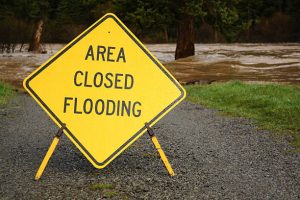Turn Around, Don’t Drown

This time of year in Iowa can bring severe weather including flash flooding. Flooding poses many hazards that everyone should keep in mind and be prepared to deal with in as safe a manner as possible.
As the term implies, flash flooding can occur very quickly with little or no notice. Flash flooding can be the result of locally heavy rain, rapid snow melt or even the failure of a dam or levee. Low lying roadways and streets can become inundated with muddy water that makes it impossible to see what lies beneath.
Many people make a serious mistake when they try to walk or drive through a flooded area. Always remember to “turn around, don’t drown.”
Here are some statistics to share with co-workers, family and friends:
Deaths: The Centers for Disease Control reports that over half of all flood–related drowning deaths each year occur when drivers attempt to drive through flood waters.
Depth of Flood Water: It is never a good idea to attempt to walk or drive through rushing flood waters. It does not take very deep water to create a serious hazard:
- An adult walking in just six inches of swiftly moving flood water can be swept off their feet.
- It only takes one foot of rushing flood water to move a small car or vehicle.
- Two feet of flood water can physically move larger vehicles.
Unseen hazards can include:
- Washed out roadways, streets or even sidewalks.
- Open manholes; lids are often pushed up and away by water pressure.
- Items in which you can become entangled such as tree branches, downed power lines, cables and fencing.
Sources: U.S. Department of Commerce; National Oceanic and Atmospheric Administration; National Weather Service
Use Caution During
Flood Clean-Up

Spring has brought flooding to various parts of the state and with the flooding comes numerous hazards. Here are a few items to consider when working in flooded areas or during clean-up. Remember the flood water has been exposed to numerous pathogens such as biologic waste and chemicals.
- If wading through flooded locations, be cautious about uneven surfaces or holes hidden under the water that could result in falls.
- Wear waders or tall waterproof boots when walking in water to prevent exposure. Also, handle anything that has been submerged in flood water with heavy, waterproof gloves to prevent cuts and scrapes that can lead to exposure from contaminates in the water.
- Always cut power to buildings during flooding to prevent accidental electrocution. Also, ensure the gas is turned off.
- Wear safety eye-wear to prevent flood water splashing in eyes. We had several claims from this last year.
- Make sure you wash thoroughly with soap and clean water after working in flooded areas.
- If you notice a musty smell while working in enclosed structures, look for mold growth. If you see mold, consider using a respirator if you are medically qualified to do so. If you can’t wear a respirator, ventilate the location.
- Make sure your tetanus shots are up to date before doing clean-up in the event you have an exposure. If you have an exposure, seek medical attention immediately.




